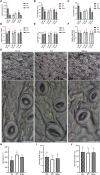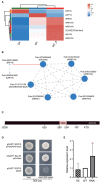PagERF16 of Populus Promotes Lateral Root Proliferation and Sensitizes to Salt Stress
- PMID: 34149765
- PMCID: PMC8213033
- DOI: 10.3389/fpls.2021.669143
PagERF16 of Populus Promotes Lateral Root Proliferation and Sensitizes to Salt Stress
Abstract
The aggravation of soil salinization limits the growth and development of plants. The AP2/ERF transcription factors (TFs) have been identified and play essential roles in plant development and stress response processes. In this study, the function of PagERF16 was detected using the overexpressing (OX) and RNAi transgenic poplar 84K hybrids. Plant growth, stomatal conductance, antioxidant enzymes activity, and PagERF16 co-expressed TFs were analyzed using morphological, physiological, and molecular methods. OX showed a more robust lateral root system with a bigger diameter and volume compared to the wild-type plants (WT). Physiological parameters indicated the bigger stomatal aperture and lower stomatal density of OX along with the lower Catalase (CAT) activity and higher malondialdehyde (MDA) content contributed to the salt sensitivity. The plant height and rooting rate of OX and RNAi were significantly worse compared to WT. Other than that, the morphology and physiology of RNAi plants were similar to WTs, suggesting that the function of PagERF16 may be redundant with other TFs. Our results indicate that when PagERF16 expression is either too high or too low, poplar growth and rooting is negatively affected. In addition, a downstream target TF, NAC45, involved in Auxin biosynthesis, was identified and PagERF16 could directly bind to its promoter to negatively regulate its expression. These results shed new light on the function of ERF TFs in plant root growth and salt stress tolerance.
Keywords: PagERF16; lateral root growth; poplar; salt sensitivity; transgenics.
Copyright © 2021 Wang, Huang, Wang, Fan, Liu and Han.
Conflict of interest statement
The authors declare that the research was conducted in the absence of any commercial or financial relationships that could be construed as a potential conflict of interest.
Figures






Similar articles
-
PagMYB205 Negatively Affects Poplar Salt Tolerance through Reactive Oxygen Species Scavenging and Root Vitality Modulation.Int J Mol Sci. 2023 Oct 22;24(20):15437. doi: 10.3390/ijms242015437. Int J Mol Sci. 2023. PMID: 37895117 Free PMC article.
-
PtaERF194 inhibits plant growth and enhances drought tolerance in poplar.Tree Physiol. 2022 Aug 6;42(8):1678-1692. doi: 10.1093/treephys/tpac026. Tree Physiol. 2022. PMID: 35220440
-
PagMYB151 facilitates proline accumulation to enhance salt tolerance of poplar.BMC Genomics. 2023 Jun 22;24(1):345. doi: 10.1186/s12864-023-09459-2. BMC Genomics. 2023. PMID: 37349699 Free PMC article.
-
A celery transcriptional repressor AgERF8 negatively modulates abscisic acid and salt tolerance.Mol Genet Genomics. 2021 Jan;296(1):179-192. doi: 10.1007/s00438-020-01738-x. Epub 2020 Nov 1. Mol Genet Genomics. 2021. PMID: 33130909
-
A salt-stress-regulator from the Poplar R2R3 MYB family integrates the regulation of lateral root emergence and ABA signaling to mediate salt stress tolerance in Arabidopsis.Plant Physiol Biochem. 2017 May;114:100-110. doi: 10.1016/j.plaphy.2017.02.018. Epub 2017 Feb 24. Plant Physiol Biochem. 2017. PMID: 28285084
Cited by
-
Aspartyl tRNA-synthetase (AspRS) gene family enhances drought tolerance in poplar through BABA-PtrIBIs-PtrVOZ signaling module.BMC Genomics. 2023 Aug 21;24(1):473. doi: 10.1186/s12864-023-09556-2. BMC Genomics. 2023. PMID: 37605104 Free PMC article.
-
The genome of hibiscus hamabo reveals its adaptation to saline and waterlogged habitat.Hortic Res. 2022 Mar 23;9:uhac067. doi: 10.1093/hr/uhac067. eCollection 2022. Hortic Res. 2022. PMID: 35480957 Free PMC article.
-
Populus euphratica plant cadmium resistance 2 mediates Cd tolerance by root efflux of Cd ions in poplar.Plant Cell Rep. 2023 Nov;42(11):1777-1789. doi: 10.1007/s00299-023-03065-y. Epub 2023 Sep 23. Plant Cell Rep. 2023. PMID: 37740037
-
PagSOD2a improves poplar salt tolerance by elevating superoxide dismutase activity and decreasing malondialdehyde contents.Front Plant Sci. 2024 Sep 13;15:1456249. doi: 10.3389/fpls.2024.1456249. eCollection 2024. Front Plant Sci. 2024. PMID: 39345981 Free PMC article.
-
Effects of Kiwifruit Rootstocks with Opposite Tolerance on Physiological Responses of Grafting Combinations under Waterlogging Stress.Plants (Basel). 2022 Aug 12;11(16):2098. doi: 10.3390/plants11162098. Plants (Basel). 2022. PMID: 36015401 Free PMC article.
References
-
- Chen S., Lin X., Zhang D. W., Li Q., Zhao X. Y., Chen S. (2019). Genome-wide analysis of NAC gene family in Betula pendula. Forests 10:741. 10.3390/f10090741 - DOI
LinkOut - more resources
Full Text Sources
Research Materials
Miscellaneous

